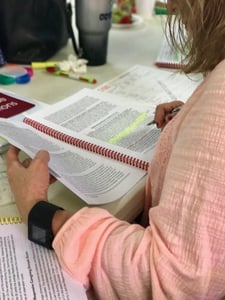
Convincing participants to move off of the manual's face pages, and into the descriptive paragraphs is a constant challenge in CLASS Observation trainings. The face page is comfortable, easy to read, concise, and concrete (you know, with all of those handy-dandy behavioral markers). The tri-fold is even easier, and tugging participants away from that resource during the coding process can be tough as well! My strategies for convincing participants that the descriptive paragraphs are an important step in the coding process starts very early in a CLASS Observation Training and continues throughout the two-days. It starts with a sort of analogy, and I call it “The Rest of the Story."
I’m going to show my age here just a bit. Do you remember Paul Harvey? Some of you do, I’m sure. Others of you may be wondering who the heck Paul Harvey is/was! I grew up listening to my local radio stations in Port Huron, Michigan: WHLS and WPHM. I’ve never been far away from a radio since I was a youngster, and I loved storytelling and true stories. Paul Harvey’s The Rest of the Story segments were always my favorites.
Quick background--Paul Harvey was a radio commentator, and had a famous segment called The Rest of the Story. From the 1970’s until about 2009, Harvey would give a backstory to news events, famous or not-so-famous people, or things. Each segment ended with him saying, in this kind of gravelly voice, “And now you know the rest of the story.”
So, I’ve affectionately nicknamed the descriptive paragraphs “The Rest of the Story.”
When I introduce the manual (you know, that first slide in the Obs PPT that has a graphic of the manual), I carefully guide the group through the face page. Then when I get to the slide with the graphic of the descriptive paragraphs, I say something like, “Okay, so you know those columns on the face pages, the ones under low, and mid, and high? Well, here in the descriptive paragraphs, notice how those columns are just the opening sentences? To code accurately, you need what I like to call, The Paul Harvey Rest of the Story! And here you will find the supports you really need to decide if an indicator fits best in the low, or the mid, or the high range. It’s these full-length paragraphs that guide you to decide the best fit for the classroom. The behavioral markers are helpful, but just guides and not a checklist!”
In my last observation training, I had participants whose ages ranged from the mid-20’s to the mid-60’s. Someone in the training always remembers Paul Harvey’s The Rest of the Story, so we get a bit of a laugh from that!
Times have changed radio-wise for me. These days, I listen to NPR, or my favorite podcasts, or Apple music. Local radio seems like a long time ago, in a galaxy far, far away. But it’s still fun to bring up “The Rest of the Story” in an Observation training, and use the catch phrase to stress the important role descriptive paragraphs have in the coding process. How do you encourage your participants to dig into those paragraphs?

